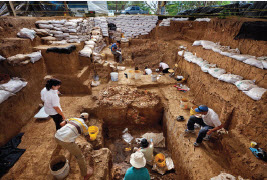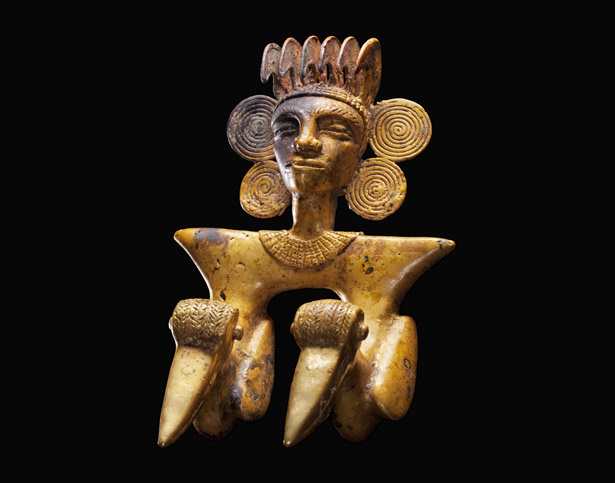This has been an exciting discovery and it is now presented in the National Geographic magazine as one of the greatest discoveries in Panama’s history.
The excavation of a cemetery more than a thousand years old has uncovered tombs of powerful warriors adorned in gold. One of the richest discoveries in the Americas in decades, the site is shining new light on a little-known culture.
“In a grassy, sun-parched field in central Panama, gold was coming out of the ground so fast that archaeologist Julia Mayo was tempted to yell, Stop, stop!,” writes author A.R. Williams. Determined to uncover new evidence of an ancient society, Mayo followed her instincts and has unearthed one of the richest discoveries in the Americas in decades.
Determined to uncover new evidence of the ancient society she had been studying since graduate school, Mayo and her team began geophysical surveys in 2005 at a site known as El Caño, named for a waterfall on one of the area’s many rivers. The results identified a circle of long-forgotten graves. By 2010 she and her team had dug a pit 16 feet deep and discovered the remains of a warrior chieftain bedecked in gold—two embossed breastplates, four arm cuffs, a bracelet of bells, a belt of hollow gold beads as plump as olives, more than 2,000 tiny spheres arranged as if once sewn to a sash, and hundreds of tubular beads tracing a zigzag pattern on a lower leg. That alone would be the find of a lifetime, but it was just the beginning. Mayo had struck a lode of treasure.
The team returned last year during the January-to-April dry season and unearthed a second burial every bit as rich as the first. Bearing two gold breastplates in front, two in back, four arm cuffs, and a luminous emerald, the deceased was surely another supreme chief. Near him lay a baby similarly adorned in gold, most likely his son. Beneath both of them stretched a layer of tangled human skeletons, possibly sacrificed slaves or war captives. Radiocarbon tests would date the burials to about A.D. 900—the era when the Maya civilization, some 800 miles to the northwest, was beginning to unravel.
Mayo barely had time to catalog the new finds before her team uncovered more gold. Glinting from the walls of the pit, the artifacts marked the edges of four more tombs. As she surveyed the scene, she couldn’t help but feel stunned. “I was just speechless—fascinated, but also worried,” she remembers. The rains had already begun, and she was now in a race to retrieve all the treasure before the neighboring river flooded the site. Also, she knew looters were sure to come if news of the discoveries got out. She swore her team to silence and prayed for clear skies.
This wasn’t the first time that an archaeological gold mine had been found in Panama. Less than two miles from where Mayo is working, excavations at Sitio Conte—named for the owners of the land—had unearthed one of the Western Hemisphere’s most spectacular collections of artifacts. That trove first came to light in the early 1900s, when a rain-swollen river sliced into a cattle pasture. Golden breastplates, pendants, and other finery began tumbling out of tombs and cascading down the riverbank.
Lured by news of the ancient cemetery, teams from Harvard and later the University of Pennsylvania set off on the six-day voyage by steamer from New York to Panama City, then made their way to Sitio Conte by horse, oxcart, and dugout canoes. During four field seasons, digging in temperatures that often topped a hundred degrees, the teams opened more than 90 tombs, many holding multiple bodies adorned in gold as well as works by highly skilled artisans: intricately painted ceramics, carved whale bones accented with gold, necklaces of sharks’ teeth, ornaments of polished serpentine and agate.
In his 1937 report Harvard archaeologist Samuel Lothrop identified the Sitio Conte people as one of the native groups the Spanish had encountered when they invaded Panama in the early 1500s. As the conquistadores marched across the isthmus, they wrote detailed chronicles of their progress. In the Sitio Conte region they found small, belligerent communities vying for control of the savannas, forests, rivers, and coastal waters. Their warrior chiefs covered themselves in gold to proclaim their rank as they fought each other and the Spanish. The conquistadores accumulated a fortune in gold for the royal coffers back in Seville as they defeated chief after chief. From one funeral alone they plundered 355 pounds of gold, including jewelry that they tore from the bodies of three chiefs who had been mummified over a smoking fire after falling in battle.
The Sitio Conte culture is much older than it first appeared to Lothrop. Experts now believe the graves of the warrior chiefs date from about the eighth to the tenth centuries. The artifacts appeared to match the descriptions left by the conquistadores because some aspects of the culture had continued unchanged until the 1500s.
By April 1940 the archaeologists working at Sitio Conte had found a wealth of dazzling artifacts for their museums, and so they departed. A few others continued to probe beneath Panama’s green pastures, but they failed to make remarkable discoveries. This stretch of Central America has none of the attractions that have drawn generations of scientists to the Maya territory to the north—no enduring architecture, dynastic histories, or evidence of intellectual accomplishments such as a calendar. The heat and humidity have rotted away ancient shelters of bamboo and thatch along with most personal possessions, leaving mainly broken pottery and stone tools.
A short walk from the same river that flows by the Sitio Conte cemetery, there is a line of tall monoliths that crosses the field at El Caño. In 1925 the stones attracted an American adventurer named Hyatt Verrill. He dug several rough holes nearby, uncovering three skeletons of commoners. Additional excavations in the 1970s and 1980s found several more modest graves but no treasure.
Despite those unpromising results, Julia Mayo had a good feeling about this site. As a research associate at the Smithsonian Tropical Research Institute in Panama City, she had studied Lothrop’s report on Sitio Conte. She knew he had found monoliths as well as graves, and she thought there might be a connection. If she was right, more burials of warrior chiefs from that same culture would be waiting underground at El Caño. It was just a question of figuring out where.
Her initial survey picked up traces of a slightly raised circle about 260 feet in diameter. Hoping it was the border of a cemetery, she started digging at dead center—and hit pay dirt. The artifacts now coming to light confirm that the Spanish descriptions of this region are generally reliable and that Sitio Conte was not a fabulous exception in an archaeological backwater.
Specialists at the Smithsonian Institution are analyzing the array of materials Mayo’s team has unearthed and have already made a major discovery. Natural impurities in the gold indicate that the metal was mined and worked in the region. This firmly puts to rest any debate about whether Panama’s treasures were imported from farther south, where cultures were supposedly older and more advanced. The native people in this area may have lived in simple huts, but they were rich enough to support master craftsmen and sophisticated enough to appreciate fine art.
Mayo believes her cemetery holds about 20 more tombs of chiefs like the two she has excavated. When she estimates how long it would take to uncover them all, the number is so extreme it sounds like a joke—until you do the arithmetic. Her team of ten works slowly, scraping back the hard alluvial soil with care to gather the smallest pieces of evidence. In four years they have exposed 2 percent of the cemetery. If work were to continue every year at that pace, the last artifact would be plucked from the ground 196 years from now.
During the digging season, as Mayo and her team eat lunch on the shady porch of El Caño’s small museum, they look out across hundreds of acres of sugarcane. Mayo believes it’s all fertile ground for archaeology. Just a few miles upriver, in fact, she has found signs of another cemetery. If it’s as rich as El Caño and Sitio Conte, this area could be Panama’s Valley of the Kings. In Egypt, though, most of the tombs have been looted. Here they should still be full of surprises.


